Inline Monitoring Services Configuration
Understanding Inline Monitoring Services
- Benefits of Inline Monitoring Services
- Inline Monitoring Services Feature Overview
- Inline Monitoring Services Configuration Overview
- Supported and Unsupported Features with Inline Monitoring Services
Benefits of Inline Monitoring Services
Flexible—Inline monitoring services allow different inline-monitoring instances to be mapped to different firewall filter terms, unlike in traditional sampling technologies, where all the instances are mapped to the Flexible PIC Concentrator (FPC). This provides you with the flexibility of sampling different streams of traffic at different rates on a single interface.
Packet format agnostic—Traditional flow collection technologies rely on packet parsing and aggregation by the network element. With inline monitoring services, the packet header is exported to the collector for further processing, but without aggregation. Thereby, you have the benefit of using arbitrary packet fields to process the monitored packets at the collector.
Inline Monitoring Services Feature Overview
Service providers and content providers typically require visibility into traffic flows to evaluate peering agreements, detect traffic anomalies and policy violations, and monitor network performance. To meet these requirements, you would traditionally export aggregate flow statistics information using JFlow or IPFIX variants.
As an alternative approach, you can sample the packet content, add metadata information, and export the monitored packets to an collector. The inline monitoring services enable you to do this on MX Series routers and on PTX routers that run Junos OS Evolved.
With inline monitoring services, you can monitor every IPv4 and IPv6 packet on both ingress and egress directions of an interface. The software encapsulates the monitored traffic in an IPFIX format and exports the actual packet up to the configured clip length to an collector for further processing. By default, Junos OS supports a maximum clip length of 126 bytes starting from the Ethernet header and Junos OS Evolved supports a maximum clip length of 256 bytes starting from the Ethernet header.
Figure 1 illustrates the IPFIX format specification.
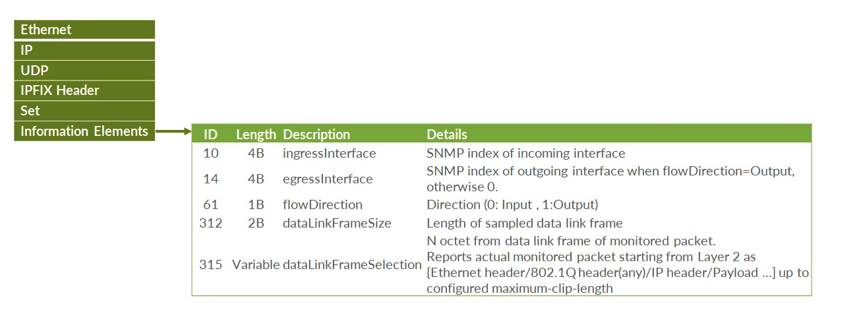
The IPFIX header and IPFIX payload are encapsulated using IP or UDP transport layer. The exported IPFIX format includes two data records and two data templates that are exported to every collector:
Data record—Includes incoming and outgoing interface, flow direction, data link frame section, and data link frame size. This information is sent to the collector only when sampled packets are being exported.
Figure 2 is a sample illustration of IPFIX data record packet.
Option data record—Includes system level information, such as exporting process ID, and sampling interval. This information is sent to the collector periodically, irrespective of whether sampling packets are being exported are not.
Figure 3 is a sample illustration of IPFIX option data record packet.
Table 1: Information Element fields in IPFIX Option Data Packet Number
Information Element ID
Information Element Length
Details
1
144
4B
Observation domain ID - An unique identifier of exporting process per IPFIX device. Purpose of this field is to limit the scope of other information element fields.
2
34
4B
Sampling interval at which the packets are sampled. 1000 indicates that one of 1000 packets is sampled.
Data template—Includes five information elements:
Ingress interface
Egress interface
Flow direction
Data link frame size
Variable data link frame selection
Figure 4 is a sample illustration of IPFIX data template packet.
Option data template—Includes flow exporter and sampling interval information.
Figure 5 is a sample illustration of IPFIX option data template packet.
When there is a new or changed inline monitoring services configuration, periodic export of data template and option data template is immediately sent to the respective collectors.
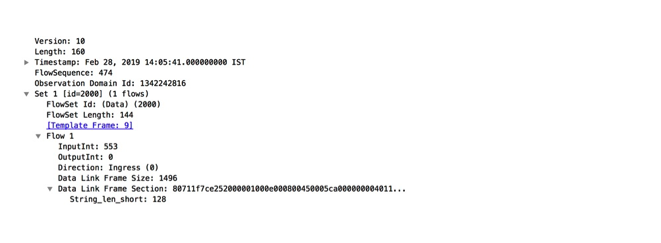
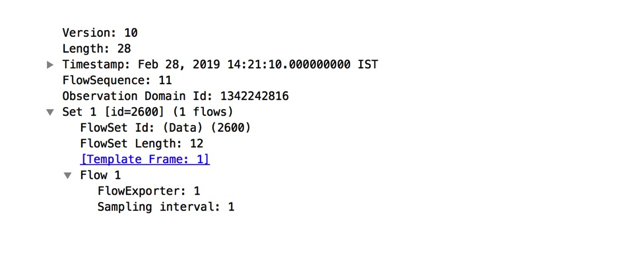
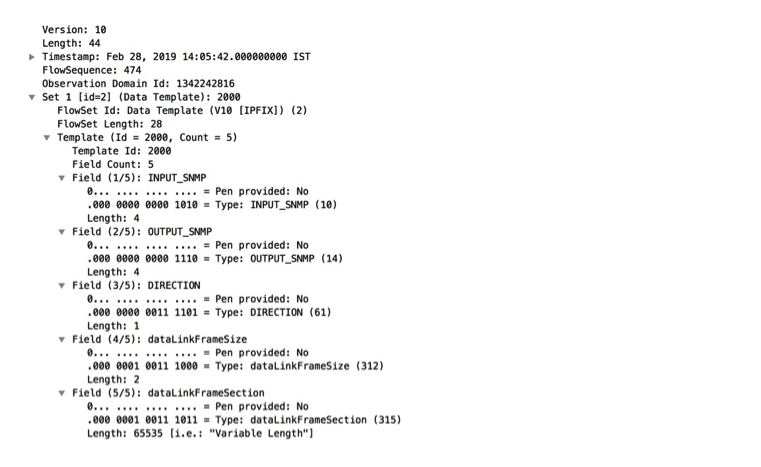
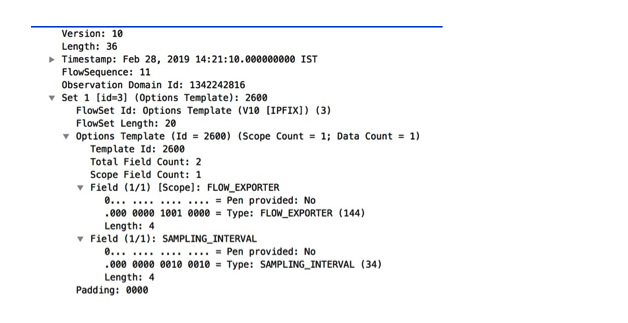
Inline Monitoring Services Configuration Overview
You can configure a maximum of sixteen (Junos OS) or seven (Junos OS Evolved) inline-monitoring instances that support template and collector-specific configuration parameters. Each inline monitoring instance supports up to four collectors (maximum of 64 collectors in total), and, for Junos OS only, you can specify different sampling rates under each collector configuration. Because of this flexibility, the inline monitoring services overcome the limitations of traditional sampling technologies, such as JFlow, sFlow, and port mirroring.
To configure inline monitoring:
-
You must include the
inline-monitoringstatement at the[edit services]hierarchy level. Here you specify the template and inline monitoring instance parameters. You must specify the collector parameters under the inline-monitoring instance. -
Specify arbitrary match conditions using a firewall filter term and an action to accept the configured inline-monitoring instance. This maps the inline-monitoring instance to the firewall term.
-
Map the firewall filter under the family
inetorinet6statement using theinline-monitoring-instancestatement at the [edit firewall filter name then] hierarchy level. Starting in Junos OS Release 21.1R1, you can also map the firewall filter under the familyany, bridge, ccc, mpls,orvplsstatements. For Junos OS Evolved, thebridgeandvplsfamilies are not supported; use theethernet-switchfamily instead. Junos OS Evolved does support theany,ccc,inet,inet6, andmplsfamilies as well. You can also alternatively apply the firewall filter to a forwarding table filter with input or output statement to filter ingress or egress packets, respectively.
Remember:
-
The device must support a maximum packet length (clip length) of 126 bytes (Junos OS) or 256 bytes (Junos OS Evolved) to enable inline monitoring services.
-
You cannot configure more than 16 (Junos OS) or 7 (Junos OS Evolved) inline-monitoring instances because of the scarcity of bits available in the packet in the forwarding path.
-
Apply inline monitoring services only on a collector interface, that is, the interface on which the collector is reachable. You must not apply inline monitoring on IPFIX traffic as this generates another IPFIX packet for sampling, thereby creating a loop. This includes inline monitoring service-generated traffic, such as template and record packets, option templates, and option record packets.
-
When inline monitoring service is enabled on aggregated Ethernet (AE) interfaces, the information element values are as follows:
Table 2: Information Element Values for Aggregated Ethernet Interfaces Direction of inline monitoring service on AE interface
Information element-10 (Incoming interface)
Information element-14 (Outgoing interface)
Ingress
SNMP ID of AE
0
Egress
SNMP ID of AE
SNMP ID of member link
-
When inline monitoring service is enabled on IRB interfaces, the information element values are as follows:
Table 3: Information Element Values for IRB Interfaces Direction of inline monitoring service on IRB interface
Information element-10 (Incoming interface)
Information element-14 (Outgoing interface)
Ingress
SNMP ID of IRB
0
Egress
SNMP ID of IRB
SNMP ID of vlan-bridge encapsulated interface
-
For XL-XM based devices (with Lookup chip (XL) and buffering ASIC (XM)), the length of the Data Link Frame Section information element in an exported packet can be shorter than the clip length even if the egress packet length is greater than clip length.
The length of the Data Link Frame Section information element is reduced by 'N' number of bytes where 'N' = (ingress packet Layer 2 encapsulation length - egress packet Layer 2 encapsulation length).
For instance, the Layer 2 encapsulation length for the ingress packet is greater than that of the egress packet when the ingress packet has MPLS labels and egress packet is of IPv4 or IPv6 type. When traffic flows from the provider edge (PE) device to the customer edge (CE) device, the ingress packet has VLAN tags and the egress packet is untagged.
In such cases, the clip length can go past the last address location of the packet head, generating a
PKT_HEAD_SIZEsystem log message. This can result in degradation of packet forwarding for the device. -
In case of inline monitoring services in the ingress direction, the
egressInterface(information element ID 14) does not report SNMP index of the output interface. This information element ID always reports value zero in case of ingress direction. The receiving collector process should identify the validity of this field based on theflowDirection(information element ID 61).
Supported and Unsupported Features with Inline Monitoring Services
Inline monitoring services supports:
-
Graceful Routing Engine switchover
-
In-service software upgrade (ISSU), nonstop software upgrade (NSSU), and nonstop active routing (NSR)
-
Ethernet interfaces and integrated routing and bridging (IRB) interfaces
-
Junos node slicing
-
Starting in Junos OS Evolved Release 22.4R1, configuring DSCP, forwarding class, or routing instances for collectors.
-
Starting in Junos OS Evolved Release 22.4R1, configuring template IDs or option template IDs.
Inline monitoring services currently does not support:
-
Configuring more than 16 (Junos OS) or 7 (Junos OS Evolved) inline-monitoring instances.
-
Junos Traffic Vision
-
Prior to Junos OS Release 21.1R1, the inline-monitoring-instance term action is supported only for
inetandinet6family firewall filters. Starting in Junos OS Release 21.1R1, it is supported for theany, bridge, ccc, mpls,andvplsfamily firewall filters. -
IPv6 addressable collectors
-
Virtual platforms
-
Logical systems
-
Configuring both the observation domain ID and observation cloud ID. You must choose only one of them.
-
An inline monitoring instance action used for exception reporting cannot be used for any other purpose, such as a firewall re-direct action or a regular inline-monitoring action.
-
An inline monitoring instance used for a firewall re-direct action cannot be used for any other purpose, such as exception reporting or a regular inline-monitoring action.
-
Prior to Junos OS Evolved Release 22.4R1, configuring DSCP, forwarding class, or routing instances for collectors.
-
Prior to Junos OS Evolved Release 22.4R1, configuring template IDs or option template IDs. The system generates these for you.
-
Configuring port mirroring and inline monitoring services under the same firewall filter term (Junos OS Evolved).
-
In the egress direction, configuring both SFlow and exception reporting; you must choose only one of them (Junos OS Evolved).
Configuring Inline Monitoring Services
The inline monitoring services can monitor both IPv4 and IPv6 traffic on both ingress and egress directions. You can enable inline monitoring on MX Series routers with MPCs (Junos OS) and on PTX routers that run Junos OS Evolved.
SUMMARY You can configure inline monitoring services to monitor different streams of traffic at different sampling rates on the same logical unit of the interface. You can also export the original packet size to an collector along with information on the interface origin for effective troubleshooting.
Before You Configure
When you configure inline monitoring services, you can:
-
Configure up to 16 (Junos OS) or 7 (Junos OS Evolved) inline-monitoring instances. Under each instance, you can configure specific collector and template parameters.
-
Configure up to 4 IPv4-addressable collectors under each inline-monitoring instance. In total, you can configure up to 64 collectors. The collectors can be remote, and at different locations.
For each collector, you can configure specific parameters, such as source and destination address, and so on. The default routing-instance name at the collector is
default.inet. -
For Junos OS, you can configure the
inetorinet6family firewall filter with the term actioninline-monitoring-instance inline-monitoring-instance-name. Starting in Junos OS Release 21.1R1, you can configureany, bridge, ccc, mpls,orvplsfamily firewall filters with the term actioninline-monitoring-instance inline-monitoring-instance-name. For Junos OS Evolved, you can configure theany, ccc, ethernet-switch, inet, inet6,ormplsfamily firewall filters with the term action inline-monitoring-instance inline-monitoring-instance-name.Each term can support a different inline-monitoring instance.
-
Attach the inline monitoring firewall filter under the family of the logical unit of the interface.
After successfully committing the configuration, you can verify the implementation of the inline monitoring services by issuing the show services inline-monitoring statistics fpc-slot command from the CLI.
If a packet requires inline monitoring services to be applied along with any of the traditional sampling technologies (such as JFlow or SFlow), the Packet Forwarding Engine performs both inline monitoring services and the traditional sampling technology on that packet. Port mirroring currently must be configured under a different term for Junos OS Evolved.
Figure 6 is a sample illustration of inline monitoring services, where traffic is monitored at two different sampling rates on the device interface, and exported to four remote collectors in an IPFIX encapsulation format. For Junos OS, you configure the sampling rate on each collector, allowing different rates for each collector. For Junos OS Evolved, you configure the sampling rate on the inline-monitoring instance, and it applies to all of the collectors configured for that instance.
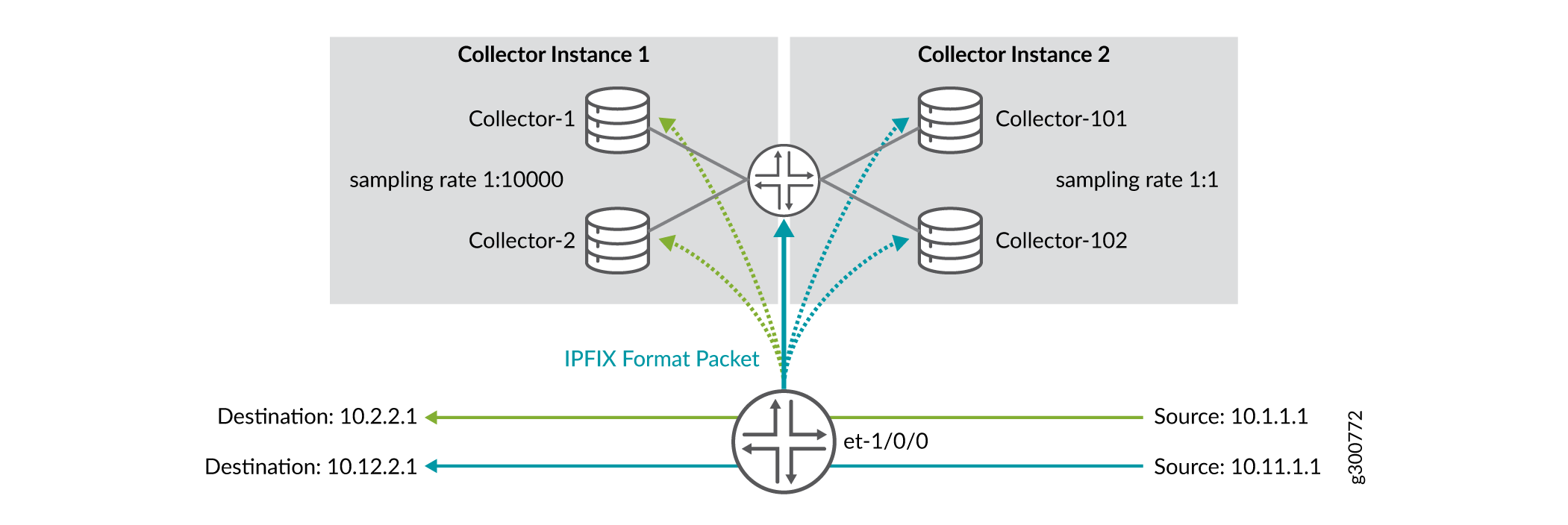
In this example, the et-1/0/0 interface of the device is configured with inline monitoring services. The details of the configurations are as follows:
-
There are two inline-monitoring instances — Instance 1 and Instance 2.
-
There are four collectors, two collectors under each inline monitoring instance.
-
Instance 1 has Collector-1 and Collector-2.
-
Instance 2 has Collector-101 and Collector-102.
-
-
The collectors on Instance 1 have a sampling rate of 1:10000.
-
The collectors on Instance 2 have a sampling rate of 1:1.
-
Instance 1 collectors have a source and destination address of 10.1.1.1 and 10.2.2.1, respectively.
-
Instance 2 collectors have a source and destination address of 10.11.1.1 and 10.12.2.1, respectively.
-
The packets are exported to the collectors in an IPFIX encapsulated format.
To configure inline monitoring services:
any, ccc, ethernet-switch, inet,
inet6, or mpls family firewall filters with the
term action inline-monitoring-instance
inline-monitoring-instance-name.any, ccc, ethernet-switch, inet, inet6, or
mpls family firewall filters with the term action
inline-monitoring-instance
inline-monitoring-instance-name.any, ccc, ethernet-switch,
inet, inet6, or mpls family firewall filters with
the term action inline-monitoring-instance
inline-monitoring-instance-name.any, bridge, ccc,
mpls, or vpls family firewall filters with the
term action inline-monitoring-instance
inline-monitoring-instance-name.